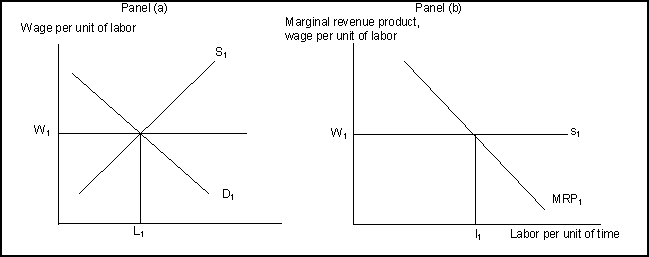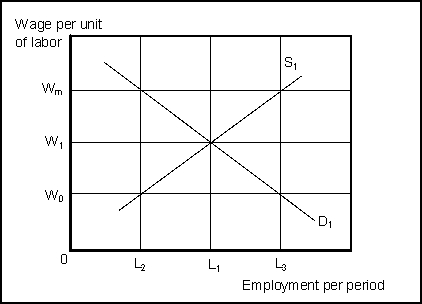A) wages in the market are determined by the intersection of demand and supply curves.
B) the wage is determined where MRP of labor is equal to the MFC of labor.
C) S₁ is the MFC of labor.
D) D₁ is the demand for leisure.
F) A) and C)
Correct Answer

verified
Correct Answer
verified
True/False
A higher wage has an income effect.
B) False
Correct Answer

verified
Correct Answer
verified
Multiple Choice
Use the following to answer question(s) : Demand and Supply of Bricklayers in a Perfectly Competitive Labor Market
 -(Exhibit: Demand and Supply of Bricklayers in a Perfectly Competitive Labor Market) If the price (wage) of bricklayers is $100, the firm's supply curve for bricklayers will be:
-(Exhibit: Demand and Supply of Bricklayers in a Perfectly Competitive Labor Market) If the price (wage) of bricklayers is $100, the firm's supply curve for bricklayers will be:
A) a vertical line at $100.
B) the same as the MRPBRICKLAYERS.
C) given by the labor market to the firm hiring bricklayers.
D) the same as its MRPBRICKLAYERS.
F) None of the above
Correct Answer

verified
Correct Answer
verified
True/False
For a resource in a perfectly competitive market, marginal revenue product is equal to the product price.
B) False
Correct Answer

verified
Correct Answer
verified
Multiple Choice
Which of the following statements is false?
A) It is likely that supply curves for labor in individual labor markets are upward sloping.
B) As wages in one industry rise relative to wages in other industries, workers shift their labor to the relatively high-wage one.
C) The mobility of labor between competitive labor markets is likely to prevent the total number of hours worked from falling as the wage rate increases.
D) Workers in one industry seldom pay attention to the wage rate(s) in other industries or labor markets.
F) A) and B)
Correct Answer

verified
Correct Answer
verified
True/False
In order to maximize profits, a firm will produce at any level of output where MRP = MP × MR.
B) False
Correct Answer

verified
Correct Answer
verified
Multiple Choice
In perfect competition:
A) the supply curve of labor to the firm is a horizontal line.
B) MFCL is greater than the price of labor.
C) MFCL is less than the price of labor.
D) MRPL equals the price of the good.
F) A) and C)
Correct Answer

verified
Correct Answer
verified
Multiple Choice
Use the following to answer question(s) : Wage Determination in Perfect Competition
 -(Exhibit: Wage Determination in Perfect Competition) Which of the following statements is true?
-(Exhibit: Wage Determination in Perfect Competition) Which of the following statements is true?
A) The firm's MFC of labor is equal to the price of the firm's output.
B) Total employment is equal to L₁, as shown in Panel (a) .
C) The individual firm is a wage setter.
D) The firm will hire L₁ units of labor, as shown in Panel (a) .
F) A) and D)
Correct Answer

verified
Correct Answer
verified
Multiple Choice
Which of the following statements is true?
A) MFC = change in total cost/ change in the quantity of a factor.
B) MRPL = MPL x (P) , where P is the price of labor.
C) MFC = the change in the quantity of a factor times the change in the price of the factor.
D) MRPL = MC of the output.
F) A) and C)
Correct Answer

verified
Correct Answer
verified
Multiple Choice
A determinant of the demand for a factor of production is the:
A) price of the factor.
B) marginal cost of the factor.
C) quantity of the factor supplied.
D) price of the product made with the factor.
F) A) and C)
Correct Answer

verified
Correct Answer
verified
Multiple Choice
A _______ wage will _______ the _______ leisure.
A) lower; increase; price of
B) higher; necessarily decrease; amount of time spent on
C) higher; increase; price of
D) lower; not affect; amount of time spent on
F) None of the above
Correct Answer

verified
Correct Answer
verified
True/False
If MFCL > MRPL, the firm should hire more labor.
B) False
Correct Answer

verified
Correct Answer
verified
True/False
Factor demand is said to be a derived demand because it depends on product demand.
B) False
Correct Answer

verified
Correct Answer
verified
Multiple Choice
Use the following to answer question(s) : The Minimum Wage
 -(Exhibit: The Minimum Wage) If it is thought that wages for some workers are not "sufficient" and a minimum wage is established at Wm, which is a wage _______ , that means that _______ workers will now be hired.
-(Exhibit: The Minimum Wage) If it is thought that wages for some workers are not "sufficient" and a minimum wage is established at Wm, which is a wage _______ , that means that _______ workers will now be hired.
A) ceiling; L₂
B) floor; L₁
C) floor; L₂
D) ceiling; L₃
F) A) and C)
Correct Answer

verified
Correct Answer
verified
Multiple Choice
Use the following to answer question(s) : Demand and Supply of Bricklayers in a Perfectly Competitive Labor Market
 -(Exhibit: Demand and Supply of Bricklayers in a Perfectly Competitive Labor Market) If the price for "bricks laid in the wall" by a bricklayer is $.10 a brick, the marginal product of the second bricklayer is _______ bricks.
-(Exhibit: Demand and Supply of Bricklayers in a Perfectly Competitive Labor Market) If the price for "bricks laid in the wall" by a bricklayer is $.10 a brick, the marginal product of the second bricklayer is _______ bricks.
A) 1,500
B) 1,400
C) 1,300
D) 1,200
F) A) and C)
Correct Answer

verified
Correct Answer
verified
Multiple Choice
Use the following to answer question(s) : The Minimum Wage
 -(Exhibit: The Minimum Wage) In equilibrium, the wage will be _______ and the quantity of labor hired will be _______ .
-(Exhibit: The Minimum Wage) In equilibrium, the wage will be _______ and the quantity of labor hired will be _______ .
A) W₀; L₂
B) W₁; L₁
C) Wm; L₃
D) Wm; L₂
F) A) and B)
Correct Answer

verified
Correct Answer
verified
Multiple Choice
The labor demand curve in a perfectly competitive factor market is the sum of all firms':
A) marginal product curves.
B) marginal revenue product curves.
C) marginal physical product curves.
D) average physical product curves.
F) All of the above
Correct Answer

verified
Correct Answer
verified
Multiple Choice
The wage paid by a firm buying labor in a perfectly competitive market:
A) does not change with the quantity of labor hired.
B) is greater than the market wage.
C) is less than the market wage.
D) increases with the quantity of labor hired.
F) A) and C)
Correct Answer

verified
Correct Answer
verified
Multiple Choice
Since the 1970s, wage inequality in the United States has _______ due primarily to _____ skill-biased technological change.
A) decreased; decreased
B) increased; decreased
C) decreased; increased
D) increased; increased
F) B) and D)
Correct Answer

verified
Correct Answer
verified
Multiple Choice
The amount by which an additional unit of a factor increases the firm's total revenue during a period is:
A) marginal revenue product.
B) average product.
C) marginal factor cost.
D) marginal physical product.
F) C) and D)
Correct Answer

verified
Correct Answer
verified
Showing 101 - 120 of 189
Related Exams